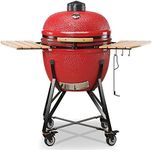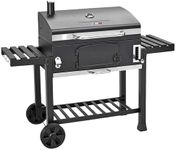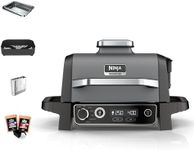Buying Guide for the Best Bbq Smokers
Choosing the right BBQ smoker can greatly enhance your outdoor cooking experience, allowing you to create delicious, smoky flavors in your meats and other foods. When selecting a BBQ smoker, it's important to consider your cooking style, the types of food you plan to smoke, and the amount of space you have available. Understanding the key specifications will help you make an informed decision that suits your needs and preferences.Type of SmokerThe type of smoker is crucial as it determines the cooking method and flavor profile. There are several types, including charcoal, electric, gas, and pellet smokers. Charcoal smokers are known for imparting a rich, smoky flavor and require more hands-on management. Electric smokers are user-friendly and maintain a consistent temperature, making them ideal for beginners. Gas smokers offer convenience and quick start-up times, while pellet smokers provide precise temperature control and a unique wood-fired taste. Choose based on your preference for flavor, convenience, and how much time you want to spend managing the smoker.
Cooking CapacityCooking capacity refers to the amount of food you can smoke at one time. It's measured in square inches of cooking space. Small smokers are suitable for individuals or small families, offering around 300-500 square inches. Medium smokers, with 500-700 square inches, are great for larger families or small gatherings. Large smokers, exceeding 700 square inches, are ideal for big parties or those who like to smoke large cuts of meat. Consider how many people you typically cook for and choose a smoker that can accommodate your needs.
Temperature RangeThe temperature range of a smoker determines the types of foods you can cook and the cooking techniques you can use. Most smokers operate between 100°F and 500°F. A wider temperature range allows for more versatility, enabling you to smoke, roast, and even grill. If you plan to smoke a variety of foods, including delicate items like fish or cheese, look for a smoker with a broad temperature range. For basic smoking needs, a standard range will suffice.
Material and Build QualityThe material and build quality of a smoker affect its durability and heat retention. Common materials include stainless steel, cast iron, and coated steel. Stainless steel is rust-resistant and easy to clean, making it a popular choice. Cast iron offers excellent heat retention but requires more maintenance to prevent rust. Coated steel is often more affordable but may not last as long. Consider how often you plan to use the smoker and the climate you live in when choosing the material.
PortabilityPortability is important if you plan to move your smoker around your yard or take it on trips. Portable smokers are typically lighter and may have wheels for easy transport. If you have limited space or enjoy camping or tailgating, a portable smoker might be the best option. For those who plan to keep the smoker in a fixed location, portability may be less of a concern.
Ease of UseEase of use refers to how simple it is to operate the smoker. Features like digital controls, built-in thermometers, and easy-to-clean components can enhance usability. Beginners may prefer smokers with automated features that require less manual intervention, while experienced smokers might enjoy the challenge of managing a more traditional setup. Consider your comfort level with smoking and how much effort you're willing to put into the process.















